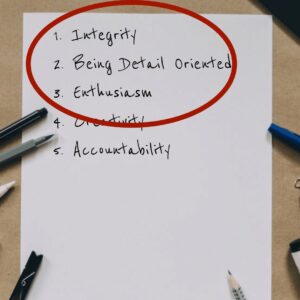Personal Vision Statement-Personal Vision Statement Generator [with Examples]

In this session, I’m going to give you step-by-step instructions on how to create a long-term vision for yourself. Successful people know that good vision statements can create positive changes in both their personal and professional life. Hard work will help you increase your success. However, an ideal vision statement can help you create a roadmap to accomplish your career goals more efficiently.
Basically, spending a little time clearly identifying your life goals will keep you moving on the right path. You’ll create a simple action plan for yourself. In my experience, having a good life vision is the most powerful tool in your toolbelt to lead to professional success.
The good news is that the process doesn’t take much time. It is fairly quick and easy. But it is also powerful. As you go through the process, I’ll give you Personal Vision Statement examples to make the process even easier!
Creating a Personal Vision Statement Is Important to Lead You to Success.
Before you create a personal vision statement, it is really important to understand why one is so important.
Back when I was in High School, my English teacher assigned us a book report. She gave us 10 or so books to choose from. Since, at the time, I wasn’t a big reader, I chose the shortest book. It was Alice in Wonderland. (Incidentally, since then I’ve read over 1000 books and even written a few.) Alice follows the White Rabbit down the hole and eventually ends up at a crossroads where she meets the Cheshire Cat. Not sure which way to go, she has this exchange with the cat.
“Would you tell me, please, which way I ought to go from here?”
“That depends a good deal on where you want to get to,” said the Cat.
“I don’t much care where–” said Alice.
“Then it doesn’t matter which way you go,” said the Cat.
“–so long as I get SOMEWHERE,” Alice added as an explanation.
“Oh, you’re sure to do that,” said the Cat, “if you only walk long enough.”
A paraphrase of this exchange is often attributed to Lewis Carrol (the author).
If you don’t know where you are going, any road will get you there. — Lewis Carroll
Although these were not the exact words, the paraphrase is often easier to use as an illustration when teaching people about creating a personal vision. Carroll used satire and exaggeration to create an interesting story and to point out human frailties and potential. Most people get to a point in their careers where they just begin to go through the motions. “as long as I do my job, I’m successful.” However, if you aren’t growing, you’re dying.
When you generate a personal vision statement for yourself, you create a roadmap to help you grow.
A Career Vision Statement Will Help You Identify New Opportunities on Your Success Journey.

Although the book was intended to be satire, true satire is funny because of the truth that it points out. Most people in business are promoted over and over again until they no longer have the skill sets to move ahead. Once a person hits this point in life, if you don’t acquire new skills, your happiness and contentment will suffer. Remember that success is not a destination. Success is a journey.
When I was just starting my training career, I had a chance to study under a fantastic teacher who was in his 70s. He was an icon in the industry. I finally got enough courage to speak to him one-on-one. I couldn’t think of anything to say, so I just said, “I hope that someday, I will be as good as you as a speaker.” He laughed at me and said, “Son, you will never be as good as me.” I was a bit startled. “What do you mean?” Without missing a beat, he said, “In order for you to catch up to me, I’d have to stop learning… And I have a 50-year head start on you.”
This speaker used his own version of a personal vision statement to continue to learn throughout his career.
Set a Goal and Then Learn by Studying Other Experts to Shorten Your Learning Curve.
I think that was one of the wisest (and most useful) things that anyone has ever said to me. The big thing that he was missing, though, was that because I was studying under him, I didn’t have to spend 50 years working through the process like he did. My learning curve was much shorter.
In the past 20 years, I have greatly passed his success level. In addition, people who studied under me have vastly passed me as well. One of the major secrets to success is that you don’t have to figure everything out on your own. All that you really have to do is figure out what you want to accomplish, and then go find someone who has already accomplished that goal. Once you find this person, just model that person’s behavior.
I played college football. So when I started The Leaders Institute ®, sometimes worked with High School coaches to help them create winning teams. I got a call from the head coach in Maypearl, Texas. He told me that he had recently taken over the football program, and they had a history of losing. The team had not had a winning season in decades. It had been over 50 years since they had been to a state playoff game. He invited me to come in and train his kids during their offseason. When I did my first session with them, though, I didn’t do a motivational speech. I taught them how to shorten their learning curve to success.
How to Shorten Your Learning Curve to Success.
I told them that most High School athletes look at the kids who have a natural athletic talent and say, “I really want to be like them.” However, if someone has a natural talent that you don’t have, wishing that you had that talent is a pipe dream. Instead, find out what you need to improve in, and then find the person on your team who has improved in that skill the most. Then, just do what he did.
For instance, if you want to be faster, go find the kid who improved his 40-yard-dash time the most in the last year. Then, just do what he did. If you want to be stronger, go find the kid who increased his squat or benchpress max the most in the last year. Then, just do what he did. The students stopped looking at their natural athletes as leaders. They replaced their leaders with the young people who were growing and improving the most.
That year, they went from a 1-9 record to 8-2 and went to their first playoff game in 50 years. These kids had used my coaching as a personal vision statement generator, and it propelled them to success.
You can do something similar in your career. Step one is to identify where you need to improve. Then, step two is to find an expert in that area and just do what he or she did. Success is easy if you have a roadmap.
Personal Vision Statement Generator
So, now that we understand the value of generating a personal vision statement, exactly how do we do it. We tried to make this entire process turnkey. Theoretically, all you really need to do is answer the questions below. Once you submit the answers, we send you an email with a clear vision statement that you can look at on a daily basis to move toward success.
Your personal vision statement can be just a single sentence, or it could be very elaborate. The main thing that you want to use the personal vision statement generator for, though, is to drive your behavior. Use it as a roadmap with milestones. This statement should be a way for you to quickly look at where you are in life and determine if you are moving toward your goal or away from it.
Step #1: Determine What Characteristics You Truly Value in Others that You Want to Emulate
When you are establishing your list of values, we aren’t talking about God, family, or country. Instead, focus on what personal characteristics you want other people to notice in you. Here is a good way to figure out what these characteristics are. Think about someone that you know who you would describe as being “successful” — however you measure success. Next, write down a list of characteristics that describe that person. What are the characteristics that this person possesses that set them apart from people who are less successful?
Below is a List of Things that We Value in Others. Use Them as a Guide for Your Own List
Integrity, Courage, Confidence, Sincerity, Being Goal Oriented, Work Ethic, Being Personable, Charisma, Fun, Determination, Enthusiasm, Dependability, Ambition, Thoroughness, Being Detail Oriented, Being Respectful, Faithfulness, Charity, Accountability, Empathy, Humility, Conviction, Optimism, Diligence, Imagination, and Creativity.
Feel free to add your own to the list. Once you have your list, identify the five characteristics that you feel are most important to success. Identify the five that, if the successful person didn’t have them, the success would crumble.
Now that you have your five, number them sequentially from one to five in order of importance.
Finally, since you now have the five characteristics listed in order, you know that one, two, and three are most important. You have moved from a list of dozens of strengths to the three most important strengths for you. Your #1, #2, and #3 items will become the first sentence of your personal vision statement.
“As a person, I value [value #1], [value #2], and [value #3] in myself and others. My goal is to have the people that I interact with see these values in me.”
Step #2: What are You Most Passionate About in Life?
Enthusiasm and passion are what make life worth living. There are certain things in your life that drive us to higher levels of success. The saddest thing that I see as a coach is when someone has just given up. I was asked to deliver a motivational speech for a youth group on an Indian Reservation years ago. The director of the tribe community center was a college graduate who was passionate about helping his people. When he left the Reservation to continue his education, his eyes were opened to the possibilities in the world. He wanted so bad to have these young people share in his optimism.
He had a serious challenge, though. Once young people on the reservation reached the age of 18, they began to get a stipend from the US government. It wasn’t a lot of money, but it was a couple of hundred US dollars every single month for free. The stipend wasn’t enough to live on by yourself. However, if a few of them shared rent on a mobile home or trailer home, they could get by. The land was provided by the Reservation, so it was free. So, without ever working, these young people could live a frugal life with multiple roommates in a trailer.
It was sad. Many of these young people had no passion for life. They had no ambition. They were just getting by. As a result, many of them turned to alcohol and drugs as recreation.
Many of us get into a similar situation, although, typically not as extreme. However, if your career, family, and faith all revolve around your passion, your life will be rewarding.
Step #2: “I am most passionate about [Fill in the Blank]. This is what drives my actions.”
Step #3: Set Goals for Your Career, Family, and Faith.
The final step in the Personal Vision Statement Generator is to set some goals for yourself. These are the “milestones” that I mentioned earlier. The accomplishment of these goals will let you know that you are moving closer to your personal vision.
My friend in college used to make fun of me when I’d give directions because I used McDonald’s as the milestones. “Take a left when you go out of the parking lot and go six blocks. You will see a McDonald’s on 6th and Main. Turn right on Main St. Then go to 9th Street and take a left. If you see a second McDonald’s, you’ve gone too far.”
Once I realized I was doing it, it was funny, but people never got lost when I gave them directions. They had milestones to guide them on the journey. Your personal goals work the same as you move toward your vision.
How to Set Personal Vision Statement Goals in Each Area of Life (EXAMPLE 1)
Your goals don’t have to be grandiose or elaborate. Simple is better. However, once you accomplish your current goal, it is important to set a new goal in each area. Here is an example of a simple and common goal.
As a person, I value Confidence, Being Goal Oriented, and Work Ethic in myself and others. My goal is to have the people that I interact with see these values in me. I am passionate about helping others increase their level of personal success in life.
Situation: My son really likes baseball, and he has been in Little League for five years. He has grown about as much as he can with the volunteer dads as coaches, though. So it might be time to move him to a “select league”. The fee is $2,000, though. In addition, the league has a total of 10 tournaments that take place on Saturday and Sunday. The tournament schedule will interfere with our regular family church time. Is the decision supported by my Personal Vision Statement? Yes. The league will help build confidence and work ethic in my son. It will also help him be more goal-oriented. So, the goals that I set need to help me move toward those values.
- Career Goal: Increase my income by at least $2,000 this year.
- Family Goal: Register my son in the Select League.
- Faith Goal: Begin to attend church on Wednesday nights as a family.
Personal Vision Statement Goals (EXAMPLE 2)
Remember, you can always change your goals. If you make them too hard or too easy, make alterations to them. The important thing is to create them and review them on a daily basis.
As a person, I value Empathy, Creativity, and Optimism in myself and others. My goal is to have the people that I interact with see these values in me. I am passionate about creative marketing ideas that bring new customers to my company.
Situation: My company increased revenue last year, but not as much as many of our competitors. My boss’s husband was recently diagnosed with cancer, so she has been taking time off work. Our company executives think that we need to focus more of our marketing on Social Media.
- Career Goal: Volunteer to head the social media project so my boss can spend more time with her husband. Increase revenue from social media by 25%. A 25% increase in revenue should generate a $2,500 annual bonus for me.
- Family Goal: Use the $2,500 bonus to take my family on a Caribbean cruise.
- Faith Goal: Offer to share what I learn on the project with our local youth group, so they can increase donations.
Just keep in mind that when you set your goals, don’t make them one-dimensional. If you set a work-goal that hurts your family and faith, you won’t be happier or more content.


